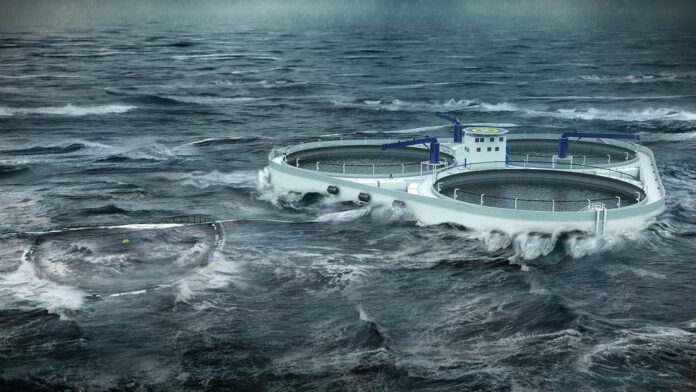The project’s radical design integrates every operation — from feeding to maintenance — within its triangular concrete structure, each side of which is 120 meters long.
Astafjord Ocean Salmon has secured eight development permits from the Norwegian Ministry of Trade and Fisheries for its revolutionary ØyMerd concept.
Each licence equates to 780 metric tons of biomass, meaning Astafjord has been granted permission to grow 6,240 tonnes of salmon.
Initially proposed in November 2017, the innovative project had previously been granted four permits, but the company appealed the decision saying that this level of biomass would be insufficient to offset the cost of research and development for the project.
Astafjord Ocean Salmon is a partnership between family-run producers Gratanglaks and Kleiva Fiskefarm. Oil-rig specialist Aker Solutions is set to construct the cutting-edge facility.
The project’s radical design is intended for locations unsuitable for traditional farming, and integrates every operation — from feeding to maintenance — within its triangular concrete structure, each side of which is 120 meters long.
Construction of the project is estimate to cost upwards of NOK 1.3 billion ($121 million), and is now set to undergo redesign in an attempt to integrate recent technological advances in the hopes of bringing costs down.
“This decision signals a momentous stride towards the realisation of ØyMerd,” chairman Tore Lundberg and general manager Marius Arvesen of Astafjord Ocean Salmon remarked in a joint press statement.
“It guarantees safety for personnel and fish, with aquatic technicians operating in stable conditions, while protecting fish from surface currents and waves, minimising lice infestation,” said Arvesen.
Norwegian oil-rig builder Aker Solutions is poised to construct ØyMerd, before towing it north for supplementary outfitting and testing. Its final berth will be in northern Norway.
A development permit is a special type of license granted to companies that want to test new technology or solutions for salmon farming. The primary goal of these licenses is to encourage innovation, especially innovations that can address environmental and spatial challenges faced by the salmon farming industry.
The Norwegian Directorate of Fisheries introduced the concept of development licenses to stimulate the development of technologies and methods that can help solve some of the key challenges in the salmon farming sector, such as sea lice infestation, fish escape, and space limitations. These licenses are typically awarded to projects that demonstrate a high degree of novelty and which involve substantial investments.

